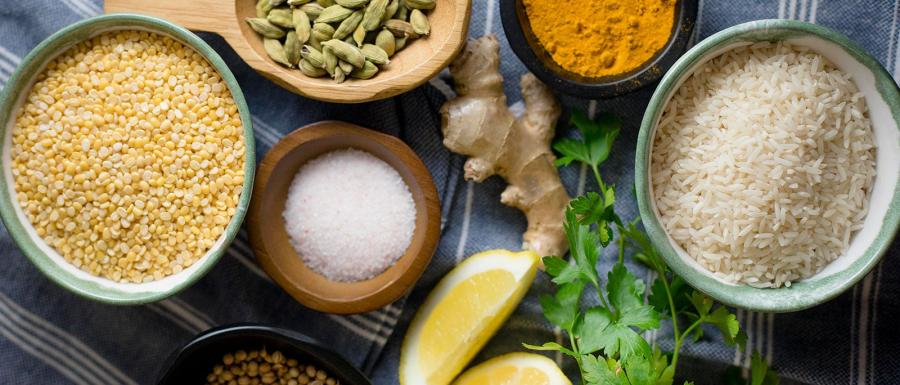How to Snack According to Your Dosha

April 3, 2020
by Claire Ragozzino
In our modern world, we’ve become masters at multitasking. We’ve created a whole category of food—from fast food to energy bars and quick shakes—to fuel us in between (or during) everything else we're doing. And because most of us are spending more time at home now, the snacking opportunities are even more available than when we're on the road. But continual snacking can take a toll on our health, so it’s important to approach these mini meals with intention.
There’s a popular saying, “You are what you digest.” How we assimilate and eliminate matters just as much as the qualities of foods we select and prepare. And how we choose to take in our food—whether we’re eating when stressed or at ease—greatly affects how we are able to digest what we consume and receive the nutrients.
When we snack, we’re often far less present than if we were sitting down for a solid meal. When we’re in a pattern of habitual snacking, it’s often because we either haven’t eaten enough at a meal, skipped a meal altogether, or are eating for entertainment and emotional comfort. In any of these cases, eating when distracted, whether physically or emotionally, can put the body in a stressed state and leave us with indigestion, bloating, and fluctuating energy levels.
There are, of course, times when we may be more active, traveling or simply needing more nourishment. At these times, it helps to know what snacks to select that bring balance rather than depletion. Equally, building awareness and healthier routines around daily eating habits can take us out of the cycle of snacking as a lifestyle.
Building Better Habits
As a rule of thumb, to improve your digestive capacity, Ayurveda recommends having two or three meals a day at the optimal hours for each, and letting the digestive system rest between those meals. If you’ve been in the habit of eating on the go or skipping meals in favor of grazing throughout the day, it might take some time and conscious effort to integrate new habits. But the results will be improved digestion and more consistent energy.
Here are a few ways to support the transition into healthier eating habits:
- Establish a routine around eating. Plan ahead and schedule time in your calendar to eat a satisfying breakfast in the morning, a heartier lunch around noon, and a lighter dinner around 6:00 pm. This can take conscious planning and practice to get used to, especially if you’ve been in the habit of grazing. To stay on track, use Google calendar or set a reminder on your phone.
- Make the meal the main event. This means leaving your phone in the other room, turning off the TV or other distractions, and sitting down to enjoy your meal with presence. If you’re sharing a meal, keep your conversation agreeable and light, or invite your dining partner to join you in silence for a few bites. Mindful eating with connection to the senses and awareness of how much you’re chewing and tasting your food can leave you feeling more satisfied at the end of the meal.
- Stay hydrated. Sometimes the desire to snack comes from a need for hydration. Try drinking warm or room-temperature water and herbal teas between meals.
- Observe your cravings. When the desire to snack arises, ask yourself whether it is true hunger or a desire for distraction. Observe whether the desire is connected to an emotion or need beyond physical hunger. If so, try going for a walk or journaling to shift the energy from a controlling craving to an opportunity to cultivate greater self-awareness.
- Snack mindfully. If it’s true hunger, then select a snack with your body’s needs in mind. If you don’t know your dosha (Ayurvedic constitution), take our quiz. Then explore the snack ideas below to mindfully nourish vata, pitta, and kapha with intentional food choices.
Snacks for Vata Dosha
For those with a vata constitution or experiencing a vata imbalance, opting for snacks that provide warm and grounding nourishment can help to reduce the dry, light, and rough qualities of this dosha. The mobile and erratic nature of vata requires routine above all else, so sticking to eating three solid meals and a lighter afternoon snack as needed can be beneficial for both digestion and energy levels. Generally, those with a weaker digestive fire and a tendency toward dryness do well to avoid the typical snack foods: crackers, chips, popcorn, cookies, dried fruits, or excessive amounts of raw foods. Instead, opt for naturally sweet, warm, oily, and cooked foods. Here are a few simple snack ideas for vata types:
- Warm date shake
- Soaked apricots
- Cooked apple with ghee and raisins
- Stuffed dates (ghee, tahini, sunflower butter, almond butter)
- Avocado slices or guacamole.
Snacks for Pitta Dosha
For those with a pitta constitution or experiencing a pitta imbalance, opt for snacks that provide cooling but substantial nourishment. Pitta can drive a voracious appetite, so it’s crucial to ensure that you’re eating enough quality food at breakfast, lunch, and dinner to satisfy you, especially if you are very active. Long periods of fasting are not beneficial for pitta. An overactive, under-fueled body can lead to burnout quickly. With that said, choosing foods that calm pitta by decreasing internal heat, nourish the digestive fire, and ground the body can help to bypass the sharp “hangry” experience. Here are a few simple snack ideas for pitta types:
- Fresh fruit
- Cucumber, zucchini, or carrot sticks
- A handful of soaked and peeled almonds
Snacks for Kapha Dosha
For those with a kapha constitution or experiencing a kapha imbalance, it’s best to skip the snacking altogether and emphasize four- to five-hour periods of fasting between meals to improve overall digestion, especially if you tend toward sluggish digestion. In general, a kapha-pacifying diet is one that brings in the light, warming, drying qualities to balance the dense, cool dampness of the earth and water elements that comprise kapha dosha. Foods to avoid include cold drinks, frozen foods, ice cream, sugary snacks, overly sour or denser sweet fruits like bananas, oily or fried foods, and heavily salted foods. The following snack ideas are suitable options for kapha:
- Fresh ginger tea with raw honey
- Savory turmeric spiced popcorn
- Rice cakes with raw kraut or kimchi
- Baked apple with ginger and cinnamon.
Snack healthy and be well!
Claire Ragozzino, a student in the Kripalu School of Ayurveda, is a certified yoga instructor and holistic nutrition educator. She founded Vidya Living to empower women to transform their lives using the tools of Ayurveda. Her first book, Living Ayurveda, will be published in fall 2020.




















































